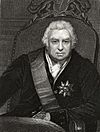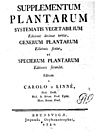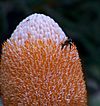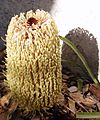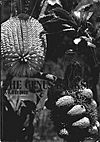Timeline of Banksia facts for kids
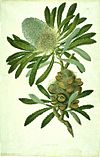
Banksia serrata painted by Sydney Parkinson when it was first found.
This article shares a timeline of how we learned more about the amazing Australian plant group called Banksia. These plants are famous for their unique flowers and seed pods. From their first discovery to modern scientific studies, this timeline shows the important steps in understanding these special plants.
Contents
Discovering Banksias: The 1700s

B. praemorsa was one of the first Banksias found in Western Australia.
- April 1770 - Sir Joseph Banks and Dr Daniel Solander found the very first Banksia plants. They collected them at Botany Bay, New South Wales. They found four types: B. serrata (Saw Banksia), B. integrifolia (Coast Banksia), B. ericifolia (Heath-leaved Banksia), and B. robur (Swamp Banksia).
- June 1770 — Banks and Solander found another type, B. dentata (Tropical Banksia), at Endeavour River, Queensland.
- 1776 — David Nelson collected B. marginata (Silver Banksia) from South Bruny Island, Tasmania.
- April 1782 — The genus Banksia was officially named by Carolus Linnaeus the Younger in his book Supplementum Plantarum. He also named four species: B. serrata, B. integrifolia, B. ericifolia, and B. dentata.
- 1788 — John White collected B. spinulosa (Hairpin Banksia).
- October–November 1791 — Archibald Menzies collected B. grandis (Bull Banksia) and B. praemorsa (Cut Leaf Banksia) in Western Australia.
- 1792 — Jacques Labillardière found B. repens (Creeping Banksia) and B. speciosa (Showy Banksia) at Esperance Bay.
- 1793 — James Edward Smith officially named B. spinulosa.
- 1793 — Luis Née collected many plants at Port Jackson, New South Wales. This included the first B. oblongifolia (Fern-leaved Banksia).
- 1798 — Carl Willdenow officially named B. grandis.
Expanding Knowledge: The 1800s
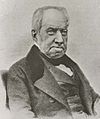
Robert Brown was very important in studying Banksias in the 1800s.
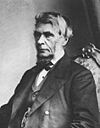
George Bentham's way of grouping Banksias lasted for over 100 years.
- 1800 — Labillardière officially named B. repens.
- 1800 — Antonio José Cavanilles officially named B. marginata, B. robur, and B. oblongifolia.
- December 1801–January 1802 — Robert Brown collected eight new Banksia species in Western Australia. He found plants like B. sphaerocarpa (Fox Banksia) and B. coccinea (Scarlet Banksia).
- 1810 — Brown published the first major way to group Banksia species. He listed 31 species in total. He divided them into two main groups.
- 1823 — Franz Sieber found the first B. spinulosa var. cunninghamii in the Blue Mountains of New South Wales.
- 1823 — William Baxter found B. gardneri (Prostrate Banksia) and B. dryandroides (Dryandra-leaved Banksia).
- 1827 — B. spinulosa var. cunninghamii was promoted to a full species, B. cunninghamii.
- March 1827 — Charles Fraser found Banksia menziesii (Firewood Banksia) in Western Australia.
- 1829 — Baxter found many new species in Western Australia, including B. caleyi (Cayley's Banksia) and Banksia brownii (Brown's Banksia).
- 1830 — Brown officially named many of Baxter's discoveries.
- late 1830s — James Drummond (botanist) found B. prionotes (Acorn Banksia).
- 1840 — John Lindley officially named B. prionotes.
- 1841 — Drummond found Banksia incana (Hoary Banksia).
- 1851 — Ferdinand von Mueller found B. ornata (Desert Banksia) in South Australia.
- 1851–1852 — Drummond found many more species, like B. leptophylla (Slender-leaved Banksia) and B. hookeriana (Hooker's Banksia).
- 1856 — Carl Meissner published his own way of grouping Banksia plants. He listed 58 species.
- 1861 — George Maxwell found B. blechnifolia and Banksia petiolaris.
- 1864 – Mueller officially named B. blechnifolia and B. petiolaris.
- 1867 — Mueller found B. oreophila (Western Mountain Banksia) in the Stirling Ranges.
- 1870 — George Bentham published a new way to group Banksia in his book Flora Australiensis. He reduced the number of species to 46. His classification was used for over 100 years.
- 1891 – B. elderiana (Swordfish Banksia) was found in the Great Victoria Desert.
- 1896 — Mueller and Ralph Tate officially named B. elderiana.
Modern Discoveries: The 1900s
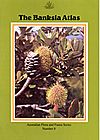
The Banksia Atlas helped us learn a lot about where Banksias grow.
- December 1926 — Charles Gardner found B. violacea (Violet Banksia) and B. audax.
- 1928 — Gardner officially named these two species.
- 1930 - Edwin Ashby found B. ashbyi (Ashby's Banksia).
- c. 1930 — William Burdett found B. burdettii (Burdett's Banksia).
- 1934 — Edmund Baker officially named B. ashbyi and B. burdettii.
- January 1940 — Gardner found B. benthamiana (Bentham's Banksia).
- July 1958 — Gardner found B. laricina (Rose-fruited Banksia).
- 1960 — Gardner found B. pilostylis (Marsh Banksia).
- 27 November 1962 — B. canei (Mountain Banksia) was identified.
- 1964 — Gardner officially named B. laricina, B. pilostylis, and B. benthamiana.
- 1967 — Willis officially named B. canei.
- 1974 — Celia Rosser started a 25-year project to paint every single Banksia species.
- 1975 — Scientists grouped Banksia closely with its relative Dryandra.
- 1981 — Alex George published a huge update on the Banksia genus. He named ten new species and nine new varieties. This was the first big review in over a century!
- 1984 — Barbara Rye promoted B. littoralis var. seminuda to a full species, B. seminuda.
- February 1984 - The Banksia Atlas project began. Over 400 volunteers helped map where Banksia plants grow across Australia.
- 1987 — George named new species like B. epica and B. oligantha (Wagin Banksia). These were found during The Banksia Atlas project.
- 1988 — The Banksia Atlas book was published.
- 1999 — George published a detailed study on Banksia as part of the Flora of Australia series.
Banksias in the 2000s

B. rosserae, the newest Banksia species found and described.
- 2000 — Celia Rosser finished her project to paint every Banksia species. The final book of her work, The Banksias, was published.
- 2000 — B. rosserae, the most recently discovered Banksia species, was found.
- 2002 — Peter Olde and Neil Marriott officially named B. rosserae.
- 2002 and 2005 — Scientists used genetic information to study Banksia. They found that Banksia and Dryandra are very closely related.
- 2007 — Scientists decided to move all Dryandra species into the Banksia genus. This means that Banksia now includes many more species!

All content from Kiddle encyclopedia articles (including the article images and facts) can be freely used under Attribution-ShareAlike license, unless stated otherwise. Cite this article:
Timeline of Banksia Facts for Kids. Kiddle Encyclopedia.

